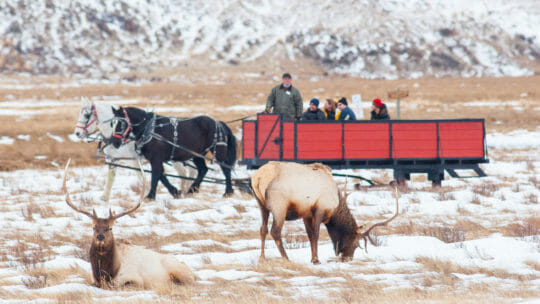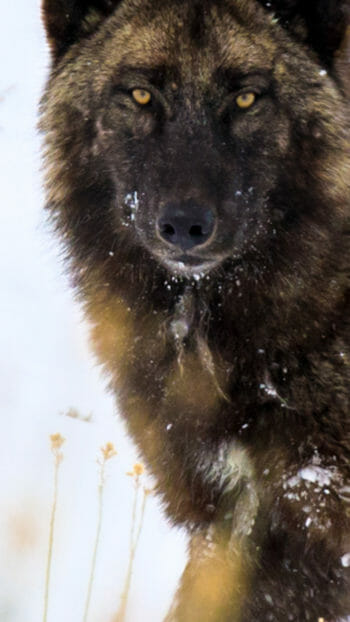Jackson, Wyoming is a gateway to one of the largest nearly intact ecosystems in the world with the highest concentration of mammals in the contiguous US. Grand Teton and Yellowstone National parks lie just north of town and offer world class wildlife watching opportunities. Another, lesser known gem is mere moments from the center of town and is a winter wonder of wildlife activity- the National Elk Refuge.
Prior to the arrival of homesteaders, elk in the Greater Yellowstone Ecosystem would migrate south in the fall towards lower elevation areas that provided winter forage and shelter from intense conditions. In the late 19th century as people began arriving in the valley to homestead, the town of Jackson began to grow. The location for the town was chosen because of the protection it receives from the elements, but that’s the very reason the elk used the area as a migration route. With the developing town and presence of people, this route became blocked and the elk couldn’t find their way to their historic winter range. Instead, they lingered around the outskirts of the town, and over the years the herd numbers declined rapidly with the added pressures of hunting from both new settlers and indigenous tribes.
By the early 1900s, there was great concern about the health of the elk herds, spurring a movement to protect them to ensure their survival. The National Elk Refuge was established in 1912 to provide protected grounds for the elk to spend the winter months. To help increase their resources through this time of scarcity, they are provided a supplementary feed. Elk travel for miles to reach the refuge; some travel down from Grand Teton National Park, neighboring national forests, and some as far as Yellowstone!

What Animals Will I See On the Refuge?
The refuge is 25,000 acres and is used as winter grounds by many other mammals like bison, mule deer, and bighorn sheep! Predators are also drawn to the refuge in the winter, with foxes and coyotes the most commonly seen and wolves occasionally spotted. Mountain lions are certainly present in the ecosystem, but they are an extremely rare sighting. Ravens are abundant and bald eagles are regularly seen perched atop trees surveying the grassy refuge. Golden eagles, while not as common as bald eagles, are an exciting sight. Red-winged black birds and trumpeter swans enjoy the aquatic habitat of Flat Creek that flows out of the refuge. A total of 47 mammals and 146 bird species use the refuge during both summer and winter months.
During the summer months, the refuge is quiet. Elk are farther north in higher elevations taking advantage of lush summer grazing. Eagles, hawks, and falcons are commonly hunting in the open grasses, and coyotes can be seen mousing. Flat Creek is alive with an abundance of birds- warblers, geese, ducks, herons, sparrows, kingfishers, swans, and more. In the fall, bird species migrate south for the winter, creating a lull in activity before things ramp up. Timing can vary depending on snowfall, but elk tend to make their way to the refuge between November and December. They are visible from mid-December until April, with anywhere between 5,000-8,000 elk! If you’re hoping for a lively and abundant scene on the elk refuge, winter is the time to visit. The refuge also provides horse-drawn sleigh rides- a charming and unique way to get closer to the elk and become immersed in the scene.


Winter Wildlife Etiquette
The national parks have guidelines on how to behave appropriately around wildlife any time of the year to protect yourself and to keep the animals safe. Some wild animals may appear passive or even friendly, but visitors must keep in mind that they are indeed wild, so they will act on instinct which means a situation can turn in a split second. This is why the law requires people to stay 25 yards from all herbivores like moose, elk, and bison, and 100 yards from carnivores like bears and wolves.
These guidelines are particularly important during winter. We need to be mindful that this is the toughest season for them; they are spending all of their time and energy finding enough to eat and staying warm, which means they can’t afford to waste energy on anything that isn’t for self preservation. When people approach wildlife too closely and make them nervous or spook them, pushing them off an area where they were grazing or resting, we have depleted some of their much needed energy reserves. One of the ways we can maintain this distance and still get a fantastic view are with the high-quality optics that each of our tours are equipped with. You will get a quality pair of binoculars for personal use throughout the tour, and your guide will have a high-powered spotting scope to set up for impressive close-ups. They can even get pictures and videos through it with your phone!
On the refuge, there are extra challenges to consider. A herd of bighorn sheep spends the winter on the sheltered side of Miller Butte which is accessible by the Refuge Road from town. The sheep frequently come down to the road which makes for some exciting viewing opportunities. Unfortunately, it also means that people tend to get too close, and the salt from roads in the winter gets on vehicles which is an attractant to wildlife who are trying to get enough sodium in their diet. It is exciting and entertaining when wild animals like bighorn sheep approach and get so close, but when they lick the salt off the cars it is a surefire way to spread diseases in the herd. They are susceptible to pneumonia which has devastated herd numbers in the past, and this winter of 2024 there is a new outbreak of orf virus, also known as contagious ecthyma, which is also transmissible to humans. Orf is not only easily spread from sheep to sheep on the cars, but it also makes people vulnerable to contracting it.
Keeping your distance from wildlife and respecting their space ensures that the animals don’t get stressed by our presence, protects them from spreading diseases, and helps them not get too habituated to people which can affect their wild behaviors in a harmful way.

Booking a Tour in Winter
When visiting Jackson Hole, we recommend booking a tour for your first day here. You will get acquainted with the area and the native wildlife with a knowledgeable guide who will provide you with fascinating information that will enrich the rest of your trip.
Book a full day Grand Teton tour to get a lay of the land and to get the most out of your time. You will be picked up by your guide early in the morning to be in the field for prime hours of wildlife movement. You will explore Grand Teton, spend time searching for wildlife on the elk refuge, enjoy lunch in a local restaurant, and take a horse-drawn sleigh ride amongst the elk herds. There’s no better way to soak up the winter magic of Jackson Hole!
Also interested in visiting Yellowstone National Park? Access is limited from Jackson in the winter months, but our 3 Day Wolves and Wildlife tour picks you up from your place of lodging and takes you into the northern range of Yellowstone- a region world renowned for wolf watching, particularly in the winter. Other animals like coyotes, foxes, bison, elk, and eagles can be spotted amongst the snowy backdrop, creating an experience you’ll never forget!
Winter is a special time to visit Jackson Hole and enjoy everything winter has to offer. Come join us and experience the National Elk Refuge in its prime!





